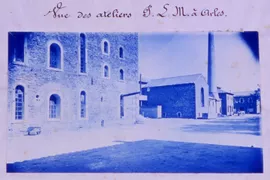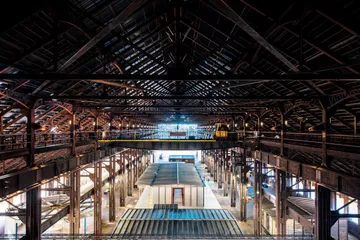
The history of the Parc des Ateliers
A former industrial wasteland, the Parc des Ateliers has morphed into a place dedicated to culture thanks to numerous initiatives launched by the region, local cultural actors, and LUMA Arles.
Key facts and figures
- 1842: adoption by the national assembly of the Talabot railway route through Arles
- 1844–1856: construction of the Parc des Ateliers on the Alyscamps necropolis
- 1984: closure of the Parc des Ateliers
- 2000: installation of the Rencontres d’Arles and Les Suds summer festivals
- 2005–2007: renovation of the Grande Halle by the PACA region
- 2013: launch of the LUMA Arles project
Origins of the site
Built in the 19th century, the Parc des Ateliers was originally an industrial site for the repair and construction of locomotives.
Built between 1844 and 1856, the Parc des Ateliers was a construction and repair site for steam locomotives belonging to the PLM (Paris-Lyon-Méditerranée) company, which became the SNCF in 1938. Its installation followed the adoption of the Talabot railway route through Arles, advocated by Lamartine in 1842 in the national assembly.
At the end of 1843, the site of the Alyscamps necropolis was chosen for the construction of this large, general workshop.
The Parc des Ateliers became an economic hub and the city’s largest employer at the beginning of the 20th century, with more than 1,800 workers on site.
During World War II, part of the production was interrupted to meet the needs of armaments manufacture and then began to collapse. Locomotive construction and repair techniques evolved with the emergence of the new electric locomotives. The machines and tools in the Parc des Ateliers were no longer suitable for use, and the Parc went downhill until it finally closed in 1984.
Site reuse and abandonment
Despite some reuse initiatives after it closed in 1984, the Parc des Ateliers was abandoned and became an industrial wasteland.
After the site closed in 1984, firms such as the Etienne paper mills and the Ducros company used some of the buildings for storage. However, in 1985–6, a series of fires on the site cut off part of the Mécanique Générale and deprived the Forges building of its roof.
In 1986, François Hébel, former director of the Rencontres d’Arles festival, organized the first photo exhibitions in the Parc des Ateliers. The site was then abandoned for about fifteen years. It became an industrial wasteland and continued to deteriorate.
A cultural site in progress
From 2000 onwards, the site underwent a gradual renaissance with the summer installation of the Rencontres d’Arles and Les Suds festivals until the LUMA Arles project was launched in 2013.
It was in the 2000s that the Parc des Ateliers found a new identity during the summer seasons. The Rencontres d’Arles festival takes over the site every summer, along with Les Suds festival, which holds concerts there, too.
This cultural renaissance was followed by the purchase of the Chaudronnerie de Fer (iron and boiler works) building in 2005 by the Provence-Alpes-Côte d’Azur region. This renovation project, entrusted to Moatti & Rivière Architects, aimed to transform the space into a cultural venue dedicated to multimedia creation, as well as digital and virtual imaging. The place was renamed La Grande Halle when it was inaugurated in 2007.
All these initiatives and the growing interest in the Parc led to the physical implementation of the LUMA Arles project in 2013.

